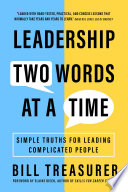

In a world filled with complexity, the ability to distill ideas into simple, actionable phrases is a powerful leadership skill. The book emphasizes that effective communication does not require elaborate jargon or convoluted explanations. Instead, leaders can convey their vision and directives through concise, two-word phrases that resonate with their teams. This simplicity fosters clarity and understanding, ensuring that everyone is on the same page. By breaking down complex concepts into digestible pieces, leaders can enhance engagement and commitment among their followers, making it easier for teams to align with the leader's goals.
Continue readingLeadership is not just about making decisions; it is also about understanding and managing emotions—both one’s own and those of others. The book highlights the significance of emotional intelligence (EQ) in leadership, arguing that leaders who are attuned to their emotions can better navigate interpersonal relationships and foster a positive work environment. By using two-word phrases that evoke emotions—such as 'Trust First' or 'Empower Others'—leaders can create an atmosphere of support and collaboration. The ability to connect on an emotional level can lead to stronger relationships, increased morale, and enhanced team performance.
Continue readingA compelling vision and a set of core values are essential for effective leadership. The author posits that leaders should articulate their vision in simple terms that inspire and motivate their teams. By using two-word phrases like 'Aim High' or 'Act Boldly,' leaders can encapsulate their aspirations and encourage their teams to strive for greatness. Additionally, embedding values into these phrases—such as 'Integrity Matters' or 'Team Wins'—ensures that the team remains focused on what truly matters. This alignment of vision and values helps create a cohesive culture where everyone understands their role in achieving the larger goals.
Continue readingLeaders must not only set a vision but also drive action. The book stresses the importance of being action-oriented and encourages leaders to adopt phrases that promote decisiveness and momentum. Phrases like 'Move Forward' or 'Stay Agile' remind teams to prioritize action and adaptability in a fast-paced environment. By fostering a culture of action, leaders can empower their teams to take initiative and make decisions that align with the organization's objectives. This proactive mindset is crucial for navigating challenges and seizing opportunities in today's dynamic landscape.
Continue readingTrust is the cornerstone of effective leadership. The author discusses how leaders can cultivate trust through transparent communication and consistent behavior. Two-word phrases such as 'Be Honest' or 'Follow Through' serve as reminders for leaders to prioritize trust-building actions. When leaders demonstrate reliability and integrity, they create an environment where team members feel safe to express their ideas and concerns. This trust not only enhances collaboration but also drives engagement and loyalty, as team members are more likely to commit to a leader they trust.
Continue readingEffective leaders know how to empower their team members and delegate responsibilities. The book emphasizes the importance of using empowering phrases like 'You Decide' or 'Lead Together' to encourage autonomy and ownership among team members. By fostering a culture of empowerment, leaders can unleash the potential of their teams, allowing individuals to take initiative and contribute to the organization’s success. This approach not only enhances team morale but also frees leaders to focus on strategic priorities, knowing that their team is capable and engaged.
Continue readingLeadership is an ongoing journey of growth and development. The book advocates for a mindset of continuous learning, urging leaders to embrace phrases like 'Learn Daily' or 'Seek Feedback.' By fostering an environment where learning is valued, leaders can encourage their teams to develop new skills, adapt to changes, and innovate. This commitment to learning not only enhances individual capabilities but also drives organizational success, as teams become more agile and responsive to emerging challenges and opportunities.
Continue reading